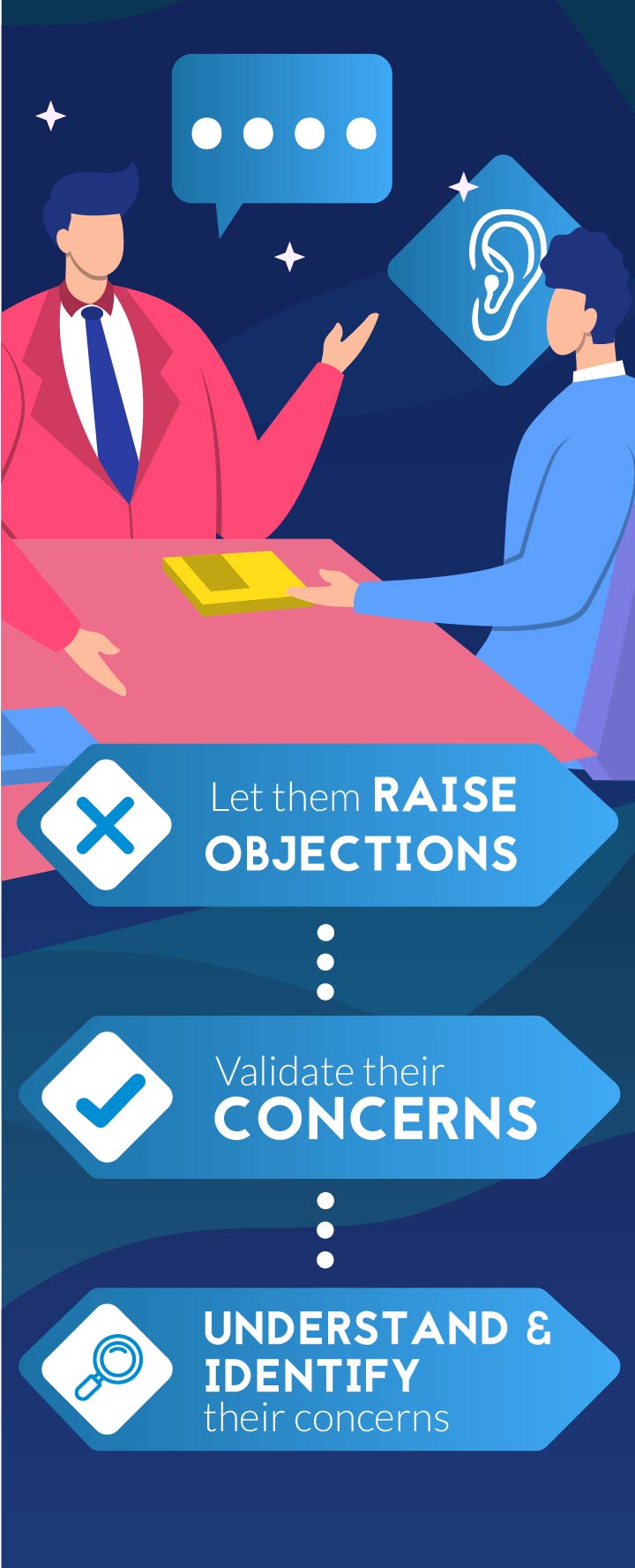
Einwände sind ein unvermeidlicher Teil des Verkaufsprozesses.
Als Vertriebsmitarbeiter ist dies ein Teil Ihrer Arbeit, den Sie bewältigen müssen. Die Art und Weise, wie Sie mit Einwänden während des Verkaufs umgehen, kann den Unterschied zwischen einem Verkaufsabschluss und dem Verlust eines Kunden ausmachen. Der Umgang mit diesen Einwänden ist eine wichtige Fähigkeit, die es zu erlernen gilt. Daher werden wir in diesem Blog untersuchen, wie man mit Einwänden im Verkauf umgeht, Beispiele für Methoden der Einwandbehandlung geben und einen schrittweisen Prozess der Einwandbehandlung skizzieren.
Methoden zur Behandlung von Kundeneinwänden
1. Aktives Zuhören
Aktives Zuhören ist eine sehr wertvolle Fähigkeit, deren Entwicklung einige Zeit in Anspruch nehmen kann. Ein Verkauf sollte sich wie ein Gespräch anfühlen, mit einem natürlichen Geben und Nehmen. Ein Vortrag ist nicht fesselnd und zeigt dem Kunden nicht, dass seine Zeit wichtig ist.
- Lassen Sie den Kunden seine Einwände vorbringen: Wenn ein Kunde ein Anliegen hat, hören Sie ihm aufmerksam zu. Berücksichtigen Sie seine Worte, bevor Sie versuchen, den Verkauf fortzusetzen.
- Bestätigen Sie ihre Bedenken: Wenn Sie einen Kunden unterbrechen oder seine Einwände abtun, kann er das Gefühl haben, nicht gehört zu werden. Bestätigen Sie die Sichtweise des Kunden, indem Sie Verständnis für sein Anliegen zeigen.
- Verstehen und erkennen Sie ihre Sorgen: Aktives Zuhören ermöglicht es Ihnen, den Kern des Einwands zu finden. Indem Sie den Kern des Anliegens erkennen, können Sie nach Lösungen suchen, die das Anliegen aufgreifen, ohne es herunterzuspielen.


2. Klären Sie den Einwand
Nachdem Sie sich den Einwand des Kunden angehört haben, müssen Sie sicherstellen, dass Sie ihn richtig verstanden haben. Sie haben aktiv zugehört und werden nun entsprechend reagieren.
- Beginnen Sie damit, das Anliegen mit offenen Fragen zu klären:
- "Können Sie mir mehr darüber sagen, warum Sie so fühlen?"
-
- "Was genau hindert Sie daran, voranzukommen?"
- Indem man dem Kunden mehr Raum zum Sprechen gibt, ist es einfacher, den besten Weg zu finden, um im Einspruchsverfahren voranzukommen.
3. Den Einwand neu formulieren
Durch die Klärung des Einwandes ist es einfacher, entsprechend zu reagieren. Die vom Kunden gegebenen Informationen ermöglichen es Ihnen, eine Antwort zu geben, die den Einwand auf eine andere Art und Weise formuliert.
- Einwände können manchmal auf einem Missverständnis oder einer falschen Wahrnehmung beruhen. In diesem Fall kann die Umformulierung des Einwands auf eine andere Art und Weise jede Verwirrung schnell ausräumen.
- Ein Missverständnis sollte schnell behoben werden. Umrahmen Sie den Einwand mit zusätzlichen Informationen oder einer anderen Perspektive, um dem Kunden zu helfen. Auf diese Weise haben Sie aktiv zugehört und durch Umformulierung der Informationen mit einer Lösung reagiert.
4. Sprechen Sie den Einwand direkt an
Nicht alle Einwände, die ein Kunde vorbringt, beruhen auf einem Missverständnis. Wenn eine Umdeutung des Anliegens nicht möglich ist, besteht eine der besten Methoden zur Behandlung von Kundeneinwänden darin, den Einwand direkt anzusprechen.
- Einwände können manchmal das Ergebnis echter Bedenken oder Herausforderungen sein. Diese Bedenken können sich auf Ihr Produkt beziehen oder vom Kunden eingebracht werden.
- Gehen Sie direkt auf den Einwand ein. Ein Einwand sollte nicht auf später verschoben werden. Bieten Sie eine Lösung an, indem Sie erklären, was Ihr Produkt bietet und wie das Problem gelöst werden kann.
5. Überwinden Sie Einwände mit Social Proof
Einige Kunden sind vielleicht daran interessiert, wie gut Ihr Produkt oder Ihre Dienstleistung funktioniert. Vor allem, wenn der Kunde das Angebot Ihres Unternehmens noch nicht kennt. Social Proof kann dem Kunden zeigen, dass Sie vertrauenswürdig und eine glaubwürdige Quelle sind.
- Was sozialer Beweis ist: Soziale Beweise können Kundenstimmen, Fallstudien oder Branchenauszeichnungen sein. Sie sind ein starkes Mittel, um Einwände zu überwinden, da sie den eindeutigen Nutzen Ihres Produkts oder Ihrer Dienstleistung zeigen.
- Was der soziale Beweis bietet: Das Angebot von Social Proof zeigt, dass Ihr Unternehmen erfolgreich war. Indem Sie zeigen, dass andere Ihr Produkt oder Ihre Dienstleistung unterstützt haben, können Sie mehr Glaubwürdigkeit und Vertrauen in das Unternehmen aufbauen.
6. Um den Verkauf bitten
Sie haben die Einwände des Kunden behandelt, Lösungen angeboten und hoffentlich die Einwände des Kunden ausgeräumt. Dies ist nun der letzte Teil des Prozesses der Einwandbehandlung.
- Die Bitte um den Verkauf sollte eine der letzten Methoden sein, um mit den Einwänden des Kunden umzugehen, denn die Einwände sollten inzwischen ausgeräumt sein. Wenn Sie den Verkauf nicht abgewickelt haben, ist es wichtig, den Kunden um den Verkauf zu bitten. Wenn Sie nicht nachfragen, kann es sein, dass der Kunde den Verkauf nicht abschließt, wenn er geht.
- Zeigen Sie, dass Sie selbstbewusst sind, und seien Sie beim Verkauf direkt. Nutzen Sie die Glaubwürdigkeit und das Vertrauen, das Sie während des Verkaufs aufgebaut haben, und respektieren Sie gleichzeitig den Kunden.
Beispiele für den Umgang mit Einwänden im Verkauf
"Ich bin nicht interessiert."
- Methode zur Behandlung von Einwänden: Formulieren Sie den Einwand neu.
Antwort: "Ich verstehe, dass Sie im Moment vielleicht nicht daran interessiert sind, aber lassen Sie mich Ihnen erklären, wie Sie von unserem Produkt profitieren können. Unser Produkt hat vielen Kunden in Ihrer Branche geholfen, Kosten zu senken und die Effizienz zu steigern. Wären Sie offen dafür, mehr darüber zu erfahren, wie wir Ihnen helfen können, ähnliche Ergebnisse zu erzielen?"
"Ihr Produkt ist zu teuer".
- Methode zur Behandlung von Einwänden: Sprechen Sie den Einwand direkt an.
Antwort: "Ich verstehe, dass der Preis für Sie eine Rolle spielt. Unser Produkt hat jedoch eine nachgewiesene Erfolgsbilanz, die unseren Kunden einen hohen ROI beschert. Durch den Einsatz unseres Produkts können Sie Ihre Gesamtkosten senken und Ihre Einnahmen steigern. Wären Sie bereit zu prüfen, wie unser Produkt Ihnen helfen kann, diese Ergebnisse zu erzielen?"
"Ich bin mit Ihrem Unternehmen nicht vertraut."
- Methode zur Behandlung von Einwänden: Überwinden Sie Einwände mit Social Proof.
Antwort: "Oh, das ist überhaupt kein Problem. Ich würde Ihnen gerne einige Erfahrungsberichte von Kunden geben, die unser Produkt sehr empfehlen. Tatsächlich hat unser Unternehmen erst kürzlich einen [Industriepreis] für unseren Service gewonnen. Ich verstehe, dass es beängstigend sein kann, einem unbekannten Unternehmen zu vertrauen, aber wären Sie bereit, ein paar Kundenstimmen zu lesen?"
"Ich muss darüber nachdenken."
- Methode zur Behandlung von Einwänden: Bitten Sie um den Verkauf.
Antwort: "Ich verstehe vollkommen, dass dies eine große Entscheidung ist. Ich glaube jedoch, dass unser Produkt die beste Lösung für Ihre Bedürfnisse ist. Kann ich Ihnen noch weitere Fragen oder Bedenken beantworten, die Sie haben? Wenn nicht, sind Sie bereit, den Kauf noch heute zu tätigen?"
Wie iDecide Vertriebsmitarbeiter in die Lage versetzt, Einwände effektiv zu bearbeiten
Sie verdienen es, dass Sie sich für Ihre Verkäufe verantwortlich fühlen. Ein erfolgreicher Verkauf kann schwierig sein, aber es gibt eine große Anzahl von Werkzeugen, die diesen Prozess erleichtern können. Natürlich sollten Sie über eine erstklassige Präsentationssoftware wie iDecide!
- Mit iDecide können Ihre Vertriebsmitarbeiter individuelle Präsentationen erstellen, die auf Ihre Bedürfnisse und Interessen zugeschnitten sind. PowerPoint-Präsentationen sind ein Relikt der Vergangenheit. Es ist an der Zeit, dass Sie Ihre Kunden richtig ansprechen.
- Wenn Ihr Vertriebsmitarbeiter während einer Verkaufspräsentation mit Einwänden konfrontiert wird, kann er die interaktiven Elemente unserer Software nutzen, um den Einwand sofort anzusprechen.
- Die interaktive Präsentationssoftware von iDecide ermöglicht es Vertriebsmitarbeitern auch, Feedback in Echtzeit einzuholen. Erkennen Sie Einwände frühzeitig und gehen Sie auf sie ein, bevor sie zu einem großen Hindernis werden.
- Schließlich bietet die Präsentationssoftware Analysen und Einblicke, die den Vertriebsmitarbeitern helfen können, Muster bei Einwänden zu erkennen und ihre Methoden zur Behandlung von Kundeneinwänden im Laufe der Zeit zu verfeinern.
